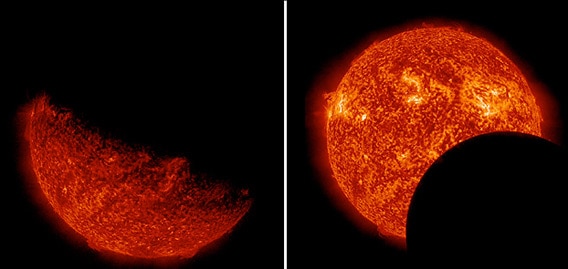Create a free profile to get unlimited access to exclusive videos, sweepstakes, and more!
Two Eclipses, Two Stories

For NASAâs Solar Dynamics Observatory, itâs eclipse season.
SDO circles the Earth in a geosynchronous orbit, meaning it makes one complete path around our planet every 24 hours. This is a special orbit, because it means to someone on Earth the satellite stays in one spot in the sky, making communication with it much easier.
But it means that twice a year the orbits of SDO and Earth line up, and the Earth irritatingly gets in the way of SDOâs view of the Sun, partially blocking it. These times are called âeclipse seasonsâ, and weâre in the middle of one of them now. On Mar. 2, the Earth got between SDO and the Sunâ¦and not only that, a few hours later the Moon did as well! Hereâs the result:
I love the two different tales of these pictures. In the picture on the right the Moonâs silhouette is sharp and distinct, but on the left the Earthâs edge is fuzzy and distorted. The reason for that is pretty obvious: We have air! There is no sharp edge to our atmosphere, and so the amount of light it blocks from the Sun varies. Brighter stuff gets through, so you can see that bright, twisting filament in the Sun is more visible through Earthâs air than the dimmer parts of the Sunâs surface.
Note how the Earthâs edge is nearly straight, too, while the Moonâs is highly curved. The Earth is far bigger than the Moon (by a factor of four in diameter), so youâd expect that. But SDO is much closer to the Earth as well, so the curve of the Earthâs edge isnât as obvious, looking more like a line.
One more thing: You might think SDOâs view of the Sun would be blocked every orbit as the Earth got in the way, but the designers accounted for that by inclining the orbit by about 29° so the Earth usually stays out of the way:
This also has the advantage of keeping it close to Earth to accommodate its pretty bandwidth-intensive data stream back to Earth. Most of the time SDO has a clear view of the Sun, like the way I drew the diagram. You can see that the orbital plane of SDO intersects the orbit of Earth at two points, called the nodes. When SDO is at one of its nodes, twice per orbit, it is in the same plane as the Earth and Sun.
Normally thatâs no big deal. But as the Earth goes around the Sun, eventually those nodes line up with the line connecting the Earth and Sun. When SDO passes through its node on the outside part of its orbit, Earth gets in the way. That alignment can happen for about three weeks, twice per year, and thatâs when we have eclipse seasons.
The Moonâs orbit is tilted with respect to the Earthâs by about 5°, so it has two nodes as well. Over time the Moon will eventually be at a node when the node aligns with the Earth-Sun line, and we get a lunar or solar eclipseâthatâs why we donât get an eclipse every month! The Moon has to be at a node at the right time to get an eclipse.
So for SDO to see Earth eclipses the geometry has to be just right⦠and then to have the Moon get in the way of the Sun is even more rare, especially on the same day!
So this year, we hit the orbital alignment jackpot. I imagine the SDO scientists are lamenting so many big objects getting in their way of the Sun, but for the rest of us it makes a pretty picture, and a fun lesson in orbital mechanics.
Check out the new Intel.com!














